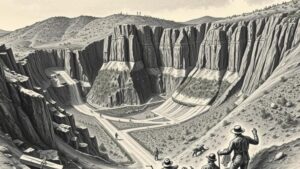Techniques for Using Dowsing to Locate Veins of Gold and Silver
Techniques for Using Dowsing to Locate Veins of Gold and Silver
Dowsing, also known as divining, is an ancient practice traditionally used to locate water, minerals, and even lost objects. In recent times, dowsing has gained popularity among prospectors who seek to find valuable veins of gold and silver. This article explores various techniques in dowsing, the tools utilized, and the rationale behind this esoteric practice, supported by relevant examples and case studies.
Understanding Dowsing
Dowsing involves using a forked stick, pendulum, or other tools to detect the presence of minerals underground. While the scientific basis for dowsing remains disputed, many practitioners claim anecdotal success in locating precious metals. Initially popularized in the 16th century, the practice has evolved into various techniques that aim to enhance the dowsers ability.
Essential Tools for Dowsing
Two main tools are commonly used in dowsing: the forked stick and the pendulum. Each tool has unique applications and is preferred by different dowsers.
- Forked Stick: Traditionally made from Y-shaped branches, dowsers hold the forked end in both hands while walking over a suspected vein. As they approach the target area, the stick may move, indicating the location of the mineral.
- Pendulum: This technique involves suspending a weighted pendulum from a string. The dowser asks specific questions and interprets the pendulums movement–swinging, circling, or remaining still–to discern information about the underground mineral deposits.
Techniques for Successful Dowsing
While the tools are fundamental, the techniques applied during dowsing sessions significantly influence outcomes. Understanding psychological and environmental factors can enhance the effectiveness of dowsing.
Mental Focus and Intention
Successful dowsing relies heavily on the dowsers mental state and intention. It is crucial for the dowser to be calm and focused before beginning the search. Many experienced dowsers engage in breathing exercises or meditation to prepare their minds. The dowser should clearly visualize the target–a vein of gold or silver–to direct their energy and intention effectively.
Location Selection
The choice of location is critical in dowsing. Areas that have historical reports of gold or silver deposits should be prioritized. Also, geological formations such as fault lines and old riverbeds are often fruitful ground for mineral discovery. For example, in 2010, dowsers in Nevada successfully located a previously unknown gold vein by applying traditional methods in conjunction with geological maps.
Experimentation with Techniques
Different dowsing techniques yield varying results based on location and personal aptitude. Dowsers are encouraged to experiment with various methods to find what resonates best for them. For example, some might find success using a combination of the forked stick and pendulum approach in a single session, alternating based on the area’s response.
Case Studies and Real-World Applications
Numerous anecdotal instances showcase the effectiveness of dowsing in locating precious metals. One notable case involves the discovery of a silver vein in Argentina, where dowsers led a geological survey to an area previously deemed unpromising. r findings prompted further exploration, eventually resulting in the establishment of a successful mining operation.
Similarly, in the United States, a group of amateur dowsers located a hidden gold seam in a well-explored area that had previously yielded little. Their persistent efforts motivated a geological team to reevaluate the site, leading to significant mineral extraction.
Addressing Skepticism
Despite many claiming success, dowsing remains controversial, largely due to a lack of empirical support. Skeptics argue that results stem from confirmation bias or the ideomotor effect–where individuals subconsciously influence their movement.
It is essential for practitioners to remain aware of these criticisms and to approach dowsing with an open mind. Regardless of scientific validation, many dowsers report positive results, often backed by experience and intuition.
Conclusion
Using dowsing as a technique to locate gold and silver veins blends traditional methods with modern exploration needs. By employing the right tools, maintaining mental focus, selecting appropriate locations, and remaining flexible in techniques, dowsers set the foundation for potentially discovering valuable mineral deposits. While skepticism about dowsing persists, the practice continues to attract interest as an intriguing blend of art and science.
Actionable Takeaways
- Choose the right dowsing tool based on your preference and comfort level.
- Prepare mentally; clear your mind and visualize your goal before starting your search.
- Focus on locations with historical mineral claims and significant geological formations.
- Experiment with different dowsing techniques to find the method that works best for you.
